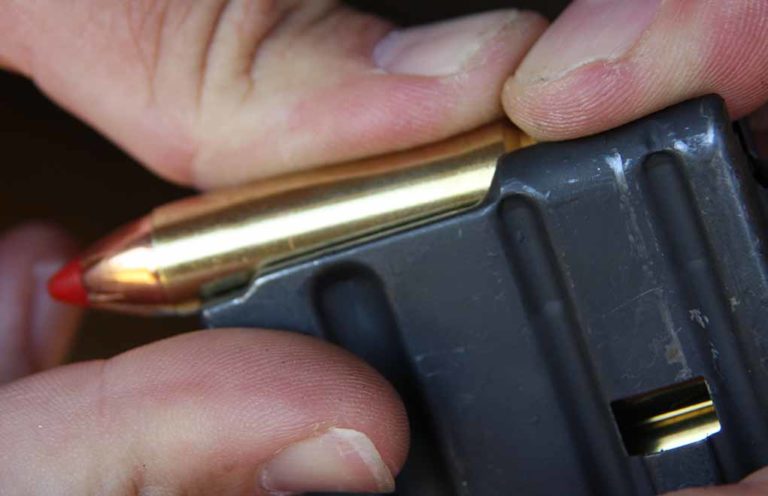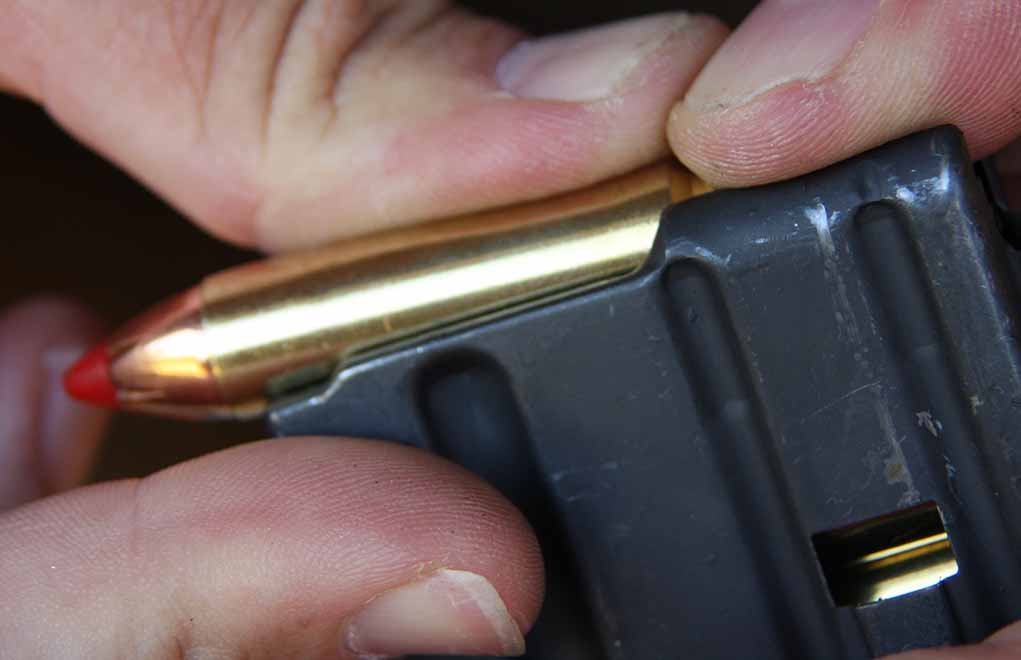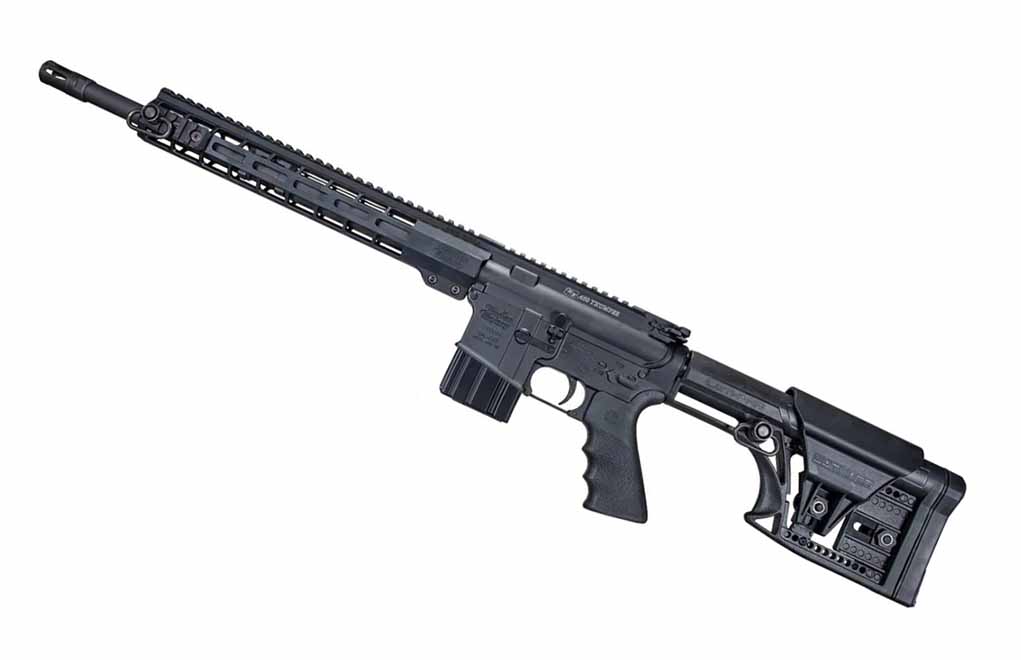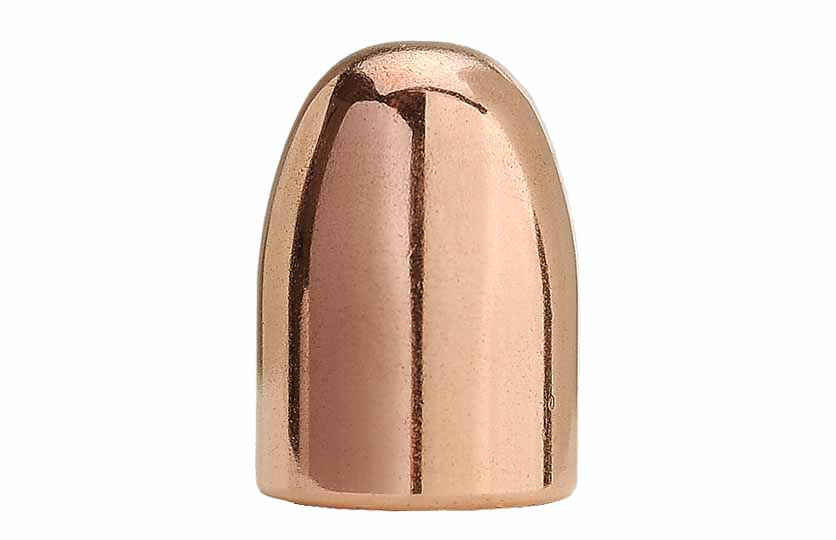

Staying flush in .450 Bushmaster ammo, given its price, can prove a challenge. That is unless you take its production into your own hands.
Why You Should Consider Reloading For The .450 Bushmaster:
- The basement for factory ammo is around $1 per round.
- Reloads, depending on brass life, can cut that in half if not by two-thirds.
- You have the potential of a much more accurate round than what you'd buy off the shelf.
- While most factory ammo is hunting focused, you have many more options off your reloading bench.
The old joke goes, if you want to know what it’s like to own a boat pour cold water over yourself while burning $100 bills. Owners of a rifle chambered in .450 Bushmaster can empathize. Not so much with the physical soaking, but with the monetary one. Trigger-time with the big-bore beast is a lot of things—fun, fruitful, impressive—but cheap isn’t one of them.
Outside .338 Lapua Mag and .50 BMG shooters and other extreme long-range cartridges, few wrangle with a more confiscatory ammunition budget than devotees of the .450 Bushmaster. Basement, you’re looking at $1 per trigger pull and it goes up steeply from there. Spendy, to say the least. Insane when compared to the typical price of widely used AR/hunting cartridges, which you can send roughly 1 ¼ to five rounds downrange for the same cost of one Bushmaster.
Just to get a better handle, here’s how several popular and common cartridges shake out per round per AmmoSeek.com:
- .223 Remington: 18₵
- .30-06 Springfield: 49₵
- .270 Winchester: 58₵
- .300 Winchester Magnum: 75₵
- .300 Blackout: 65₵
Quite a pickle, one that has ramifications. Proficiency and mastery depend on training. The more it costs to train, likely the less you’ll do. The less you do, the more your proficiency suffers. In short, not good.
Economics Of .450 Bushmaster Ammo
So, why the top dollar when it comes to .450 Bushmaster ammo? It’s history mainly. Designed more than a decade ago, the main purpose of the .450 Bushmaster was a hunting round for the AR that hit harder than the standard .223. Mission accomplished, with the cartridge more than capable of kicking a 250-grain bullet out at 2,200 fps at the muzzle. More than enough to put any whitetail into permanent relaxation.

Hornady was fast out of the gates with an excellent load topped with a 250-grain Flex Tip bullet designed for the Bushy. From there, the concept and ammo options proved a slow burn.
The .450 Bushmaster ammo market never really caught fire from there, until certain Midwestern states greenlit the cartridge for their deer seasons. This spurred some growth in ammunition options, with Remington, Winchester and others getting into the game. But overall, demand was regional. No reason to dial the .450 Bushmaster ammunition line to 11 if there was only marginal interest outside some of the Great Lakes states.
In turn, the majority of the factory-loaded stuff is all hunting oriented, generally loaded with a bullet purpose-built for the job and expected to sell in mass in only a few states. Unfortunate, given .450 Bushmaster ammo is ripe for diversification, given its inherent design.
A Different Route To .450 Affordability
The .450 Bushmaster is a rifle cartridge, but loaded with a pistol bullet. A fairly abundant pistol bullet to boot—. 45-caliber (.452). True enough, not all .45 bullets are up to the demands of the .450 Bushmaster—generally speaking, it's got to be the variety meant for souped-up .45 Colt or .454 Casull. But given the popularity of these calibers, there is still a wealth of options—affordable ones at that. Which means, you guessed it, the .450 Bushmaster is ripe for reloading.

True enough, handloading takes the pressure off your wallet no matter the caliber, but it’s absurd with the Bushy. Assuming you’ll use the bass a minimum of four times (a very conservative estimation), it’s possible to whittle down your per-round .450 Bushmaster ammo costs to less than half that of the factory stuff. Twice as much training for the same cost, perhaps three times as much if you’re a savvy reloading components shopper.
Even better, you have the opportunity to greatly diversify your .450 Bushmaster ammo options. Be it an FMJ target round or a gas-checked lead hunter, you have a wealth of possibilities when it comes to loading for this behemoth.
Go Big!:
- The Big, Big Bore: .450 Bushmaster
- .350 Legend Vs .450 Bushmaster: Does One Win Out For Hunting?
- Top .450 Bushmaster Upper Options–Complete And Stripped
- Five Top Big-Bore AR and Cartridge Options
- Big-Bore AR Evolution Is Larger Than Life
- Choosing A Big-Bore Cartridge And Rifle
- Finding The Right Big-Bore Rifle Optic
Aside from the standard reloading advice of building up your loads, piecing together your own .450 Bushmaster ammo doesn’t hold a ton of surprise. Being straight-walled case with a slight, special attention must be paid to expanding the mouth before seating the bullet, then crimping after the bullet is seated. In both cases, a little goes a long way. In particular with the crimp, given the cartridge headspaces off the mouth. A few thousands of an inch is enough to get the job done.
Case length can end up being an afterthought for many with straight-wall cases, but this is a mistake if your Bushmaster happens to be an AR-15. It is wise to keep to book numbers and trim to length unless you enjoy clearing jams.

As to powder, most .450 Bushmaster ammo calls for propellants with burn rates similar to big-bore handguns—in the medium range. Unusually, a crowd favorite for the cartridge is Hodgdon’s Lil Gun, a specialty powder developed for .410 shotguns. It and most powders match well with a 250- to 260-grain bullet, particularly standbys such as Hornady Flex Tip, which moderately improve the bullet’s ballistic coefficient. Not quite consistent MOA improvement, but dead-on minute of deer for certain.
No matter your choice of components and power, you should keep your expectations within reason. Out to 200 yards, the .450 Bushmaster tends to be flat shooting and with enough tinkering and familiarity with your rifle, you can get respectable accuracy. But you’re also dealing with bullets—by and large—with poor sectional density—essentially how well they’ll penetrate. In turn, especially for hunting, you shouldn’t go in thinking you’re going to cook up a magical round that's going to double the effective range of your Bushmaster.
Parting Shot
Big-bore rifles still have a place in the pantheon of shooting, particularly the modern iterations made to beef up the tried-and-true AR platform. Not only are they unique, but for certain geographical regions, they’re indispensable tools for hunting. Even with more competition to the market, the .450 Bushmaster will remain the first choice for many, especially if they take the time to reduce the cost of feed one.

Next Step: Get your FREE Printable Target Pack
Enhance your shooting precision with our 62 MOA Targets, perfect for rifles and handguns. Crafted in collaboration with Storm Tactical for accuracy and versatility.
Subscribe to the Gun Digest email newsletter and get your downloadable target pack sent straight to your inbox. Stay updated with the latest firearms info in the industry.

![Best Concealed Carry Guns In 2025 [Field Tested] Wilson Combat EDC X9S 1](https://gundigest.com/wp-content/uploads/Wilson-Combat-EDC-X9S-1-324x160.jpg)


![Best 9mm Carbine: Affordable PCCs [Tested] Ruger Carbine Shooting](https://gundigest.com/wp-content/uploads/Ruger-Carbine-Shooting-100x70.jpg)
![Best AR-15: Top Options Available Today [Field Tested] Harrington and Richardson PSA XM177E2 feature](https://gundigest.com/wp-content/uploads/Harrington-and-Richardson-PSA-XM177E2-feature-100x70.jpg)

check out star gun shop
for the best in the industry
Built a 450 Bushmaster on a Savage Axis action using a Rhineland Arms 16″ barrel with 16″ twist. I’ve been doing a lot of experimenting with cast bullet loads and have resized some of my 45-70 cast bullets to .452. A 405 grain RNFP over 11.4 grains of Unique in Hornady brass and lit by a Win SR primer has yielded 1073 fps and a three shot group of .473″ at 100 yards. Energy at 100 yards is still 997 ft/lbs. a 300 grain cast gas check over 21.5 grains of Lil Gun lit by a CCI 400 primer yielded 1475 fps and .998″ at 100 yards. all loads in Hornady brass.
I used a Bushmaster 450 last hunting season, the bullets were hand loaded the grain bullet was 250 grains with litl gun powder, a nice buck showed up just before dark on the last day of either sex either spe. it too one shot at 75 yards and i deer, it kicks like a 12 gage but when you are aiming and fireing you don’t really feel the recoil.